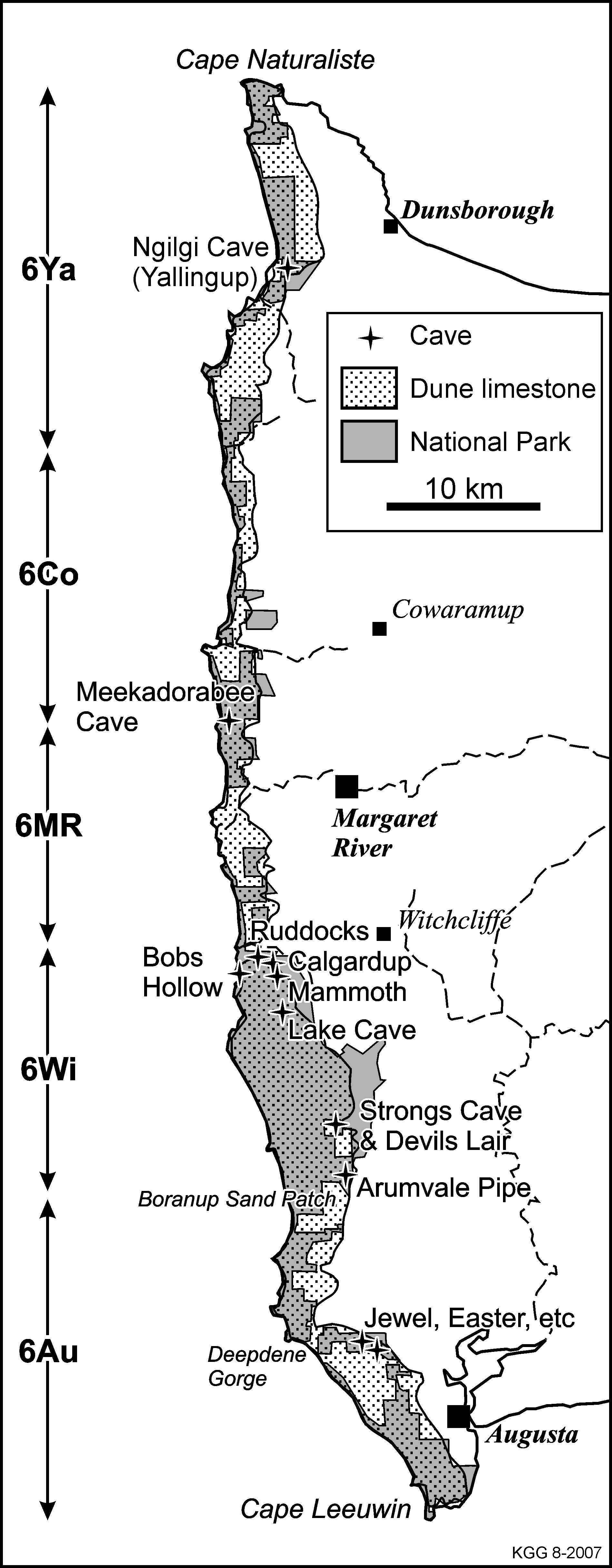CAVE MANAGEMENT IN THE LEEUWIN – NATURALISTE, AN ACCIDENT OF HISTORY
Caves Manager Dept Environment and Conservation, Blackwood District
The main purpose of this brief paper is to provide an outline of the various bodies involved with the management of caves and karst in the South West Capes area. The area under discussion is the karst area found on the Leeuwin-Naturaliste Ridge, from Cape Naturaliste in the north to Cape Leeuwin in the south.

Figure 1.
In 1901 the Caves Board, a committee to protect and administer the South West Caves was formed. Dr John Winthrop Hackett, a man of great influence and one of the founders of the University of Western Australia was the main driving force behind the formation of the Caves Board. Col. Ernest Albert Le Souef, who was responsible for the establishment of the Perth Zoo at the request of the WA Govt, was another notable member of the Caves Board. From 1901 to 1910 the Caves Board was responsible for overseeing the management of show caves in the SW of Western Australia. Steps & gates were installed in many caves, including Yallingup Cave (now Ngilgi), Northcote Grotto, Milligans Cave, Blackboy Hollow Cave, Wallcliffe Cave, Witchcliffe Cave, Calgardup Cave, Mammoth Cave, Lake Cave, Bride Cave, Giants Cave, Golgotha Cave, Deepdene Cave, and Moondyne Cave. The earliest reserves in the Leeuwin-Naturaliste area were set aside in 1902 for the purpose of “protection and preservation of caves and flora and for health and pleasure resort”. In 1911 the Caves Board was dissolved.
Responsibility for the management of the caves reserves eventually passed to the State Hotels Department, a body having an association with tourism. However State Hotels had no interest in the management of the reserves, only in the management of hotels, including Caves House at Yallingup. The period of State Hotels management was marked by neglect and infrastructure decline. In 1958 the Augusta Margaret River Tourist Bureau took out leases of four 40 acre blocks surrounding Mammoth, Lake, Deepdene and Moondyne Caves from State Hotels. The State Hotels Department ceased to exist in 1960, leaving the management of Yallingup Cave with the Busselton Tourist Bureau and the management of Mammoth, Lake, Moondyne and the recently opened Jewel Cave with the Augusta Margaret River Tourist Bureau.
Since 1902 when the first reserves were set aside there have been many additions and now most of the limestone and karst features in this region are within the Leeuwin-Naturaliste National Park (LNNP), which is made up of 36 separate reserves originally gazetted between 1902 and 2004. Figure 1 shows the area of limestone and the area of national park.
In the present day the Department of Environment and Conservation (DEC) manages the Leeuwin-Naturaliste National Park. Two of the caves within the park, Calgardup and Giants, are open to the public. Both these caves are self-guided by the light of a hand held or helmet mounted light. Calgardup Cave is no more difficult to access than a typical show cave as it is fitted out with boardwalks and stairs. Giants Cave is a little more adventurous with some rock scrambling and vertical ladders to negotiate. Entry to all other caves in the LNNP is controlled via the Cave and Abseil Permit System. Under the permit system, about ten sites are classified as “Adventure Caves” and the rest as “Restricted Access”. An accredited leader is needed to book a permit. The main users of adventure caves are school groups and commercial tour operators. There are well over 100 caves within the LNNP and many other karst features.
The two tourism associations continue to manage the better known show caves. Geographe Bay Tourism Association (formerly Busselton Tourist Bureau) manages Ngilgi Cave (formerly Yallingup Cave). The Augusta Margaret River Tourism Association manages Lake, Mammoth, Jewel and Moondyne Caves. These show caves are within national park, but on separate locations vested in each of the two tourism associations. Figure 2 shows the national park coloured green, including some of the better known DEC managed sites such as Calgardup, Giants, Bride, and Golgotha Caves. The locations of the sites managed by the two tourism associations are also indicated on Figure 2.

Figure 2.
There are some caves and karst areas not included in those discussed above. The Shire of Augusta Margaret River has some reserves containing karst features. The most notable of these is Wallcliffe Cave on the southern bank of the Margaret River, not far from the coast. There are also a few caves found on private property, particularly in the northern part of the Leeuwin-Naturaliste ridge where the national park is quite patchy and does not include large areas of karst.